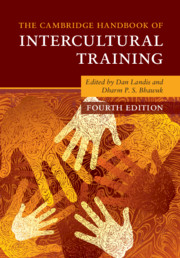Book contents
- The Cambridge Handbook of Intercultural Training
- Reviews
- The Cambridge Handbook of Intercultural Training
- Copyright page
- Dedication
- Frontispiece
- Contents
- Figures
- Tables
- Editors and Contributors
- Foreword
- Preface
- 1 Introduction and Theoretical Framework
- Part I Theoretical Foundations of Intercultural Training
- 2 Harry Triandis’s Contributions to Intercultural Training as a Field of Research
- 3 Interdisciplinary History of Intercultural Communication Studies
- 4 Culture Theories and Intercultural Training
- 5 An Analysis of Methods for Intercultural Training
- 6 Intercultural Simulations
- 7 Toward a Social Network Theory of Reentry
- 8 Intractable Conflict, Delegitimization, and Intercultural Training
- 9 Evaluation of Cross-Cultural Training
- Part II Practice of Intercultural Training
- Part III Indigenous Psychology and Intercultural Training
- Part IV New Interdisciplinary Approaches to Intercultural Training
- Part V Summing Up
- Index
- References
4 - Culture Theories and Intercultural Training
from Part I - Theoretical Foundations of Intercultural Training
Published online by Cambridge University Press: 18 September 2020
- The Cambridge Handbook of Intercultural Training
- Reviews
- The Cambridge Handbook of Intercultural Training
- Copyright page
- Dedication
- Frontispiece
- Contents
- Figures
- Tables
- Editors and Contributors
- Foreword
- Preface
- 1 Introduction and Theoretical Framework
- Part I Theoretical Foundations of Intercultural Training
- 2 Harry Triandis’s Contributions to Intercultural Training as a Field of Research
- 3 Interdisciplinary History of Intercultural Communication Studies
- 4 Culture Theories and Intercultural Training
- 5 An Analysis of Methods for Intercultural Training
- 6 Intercultural Simulations
- 7 Toward a Social Network Theory of Reentry
- 8 Intractable Conflict, Delegitimization, and Intercultural Training
- 9 Evaluation of Cross-Cultural Training
- Part II Practice of Intercultural Training
- Part III Indigenous Psychology and Intercultural Training
- Part IV New Interdisciplinary Approaches to Intercultural Training
- Part V Summing Up
- Index
- References
Summary
In this chapter, the universal theories developed by cultural researchers that can be applied across geographic regions are reviewed. The theories reviewed include early works of Parsons and Shils (pattern variables), Kluckhohn and Strodtbeck (universal human value orientations), and Hall (values associated with time and space). Following this the constructs of tightness and looseness by Pelto, and later Gelfand, a framework for traditional and modern values by Inkles, and later postmodern values by Inglehart, and instrumental and terminal values by Rokeach are discussed.Next, the cultural dimensions presented by Hofstede, individualism and collectivism, power distance, uncertainty avoidance, masculinity versus femininity, which were supplemented by Bond and colleagues’ work (long-term orientation) and Minkov’s work (indulgence versus restraint) are reviewed. House and colleagues’ GLOBE Project and its contributions to Hofstede’s framework is noted. Schwartz and colleagues work on a universal framework of values, cultural complexity, social exchange patterns identified by Fiske, and Social axioms presented by Leung and Bond are also briefly reviewed. The chapter is concluded with a discussion of the implications of cultural theories for intercultural training.
Keywords
- Type
- Chapter
- Information
- The Cambridge Handbook of Intercultural Training , pp. 164 - 191Publisher: Cambridge University PressPrint publication year: 2020
References
- 1
- Cited by

